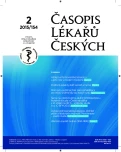Use of pulmonary rehabilitation in the treatment of decreased respiratory muscle strength
Authors:
Kateřina Neumannová
Authors‘ workplace:
Katedra přírodních věd v kinantropologii a katedra fyzioterapie, Fakulta tělesné kultury, Univerzita Palackého, Olomouc
Published in:
Čas. Lék. čes. 2015; 154: 72-78
Category:
Review Article
Overview
Decreased respiratory muscle strength could lead to other health problems, which can decrease the quality of life of those patients. Ineffective expectoration and dyspnoea during physical activities and during activity of daily living are the most frequent disorders associated with decreased respiratory muscle strength. Multidisciplinary treatment including pulmonary rehabilitation programme is very important for those patients. Ventilatory muscle training (strength and endurance type of training), airway clearance techniques – active (e.g. autogenic drainage, instrumental techniques) and passive (e.g. manual thoracic compression, mechanical insufflator/exsufflator machine) and exercise training are the most frequent used techniques in these patients. Assessment of all respiratory muscles function – especially their respiratory and postural function – is important at the beginning of rehabilitation treatment.
Keywords:
ventilatory muscle training, cough – maximal inspiratory and expiratory mouth pressures – airway clearance techniques
Sources
1. Watchie J. Cardiopulmonary assessment. In Watchie J. Cardiovascular and pulmonary physical therapy. A clinical manual. St. Louis: Elsevier Saunders 2010; 222–297.
2. Cahalin LP. Pulmonary evaluation. In DeTurk W, Cahalin L. Cardiovascular and pulmonary physical therapy. New York: McGraw-Hill 2004; 221–272.
3. Gosselink R, Dal Corso S. Respiratory muscle testing. In Frownfelter, D., Dean, E. Cardiovascular and pulmonary physical therapy. Evidence to practice. St. Louis: Elsevier Mosby 2012; 419–430.
4. Motram CD. Specializes test regimens. In: Motram, C. D. Ruppel’s manual of pulmonary function testing. Missouri: Elsevier Mosby 2013; 321–352.
5. Novák M, Paleček F. Svaly a hrudník. In Paleček F. Patofyziologie dýchání. Praha: Academia 1999; 65–88.
6. Chaves R, Carvalho de Miranda, Suesada M, Polisel F, Cristinade Sá C, Navarro-Rodriguez T. Respiratory physiotherapy can increase lower esophageal sphincter pressure in GERD patients. Respir Med, 2012; 106 : 1794–1799.
7. Kolář P. Vyšetření posturální stabilizace a posturální reaktibility. In Kolář P, et al. Rehabilitace v klinické praxi. Praha: Galén 2010; 51–56.
8. Neumannová K, Kolek V, a kol. Asthma bronchiale a chronická obstrukční plicní nemoc – možnosti komplexní léčby z pohledu fyzioterapeuta. Praha: Mladá Fronta 2012.
9. Chaitow L. Biomechanical influences on breathing. In Chaitow L, Bradley D, Gilbert Ch. Multidisciplinary approaches to breathing pattern disorders. Edinburg: Churchill Livingstone 2002a; 83–109.
10. Hillegass E. Examination and assessment procedures. In Hillegass E. Cardiopulmonary physical therapy. St. Louis: Elsevier Saunders 2011; 534–567.
11. Lewit K. Manipulační léčba v myoskeletální medicíně. Praha: Sdělovací technika 2003.
12. McCool FD. Global physiology and patophysiology of Cough. Chest 2006; 129 : 48S–53S.
13. Polverino M, Polverino F, Fasolino M, Ando F, Alfieri A, De Blasio F. Anatomy and neuro-pathophysiology of cough reflex arc. Multidisciplinary respiratory medicine 2012; 7 : 1–5.
14. Rodrigues J, Watchie J. Cardiovascular and pulmonary physical therapy treatment. In: Watchie, J. Cardiovascular and pulmonary physical therapy. A clinical manual. St. Louis: Elsevier Saunders 2010; 298–341.
15. Sciaky A, Pawlik A. Intervention for acute cardiopulmonary condition. In Hillegass E. Cardiopulmonary physical therapy. St. Louis: Elsevier Saunders 2011; 568–598.
16. Crouch R. Pulmonary rehabilitation. In Hillegass E. Cardiopulmonary physical therapy. St. Louis: Elsevier Saunders 2011; 638–658.
17. Frownfellter D, Massery M. Facilitating airway clearance techniques with coughing techniques. In Frownfelter D, Dean E. Cardiovascular and pulmonary physical therapy. Evidence to practice. St. Louis: Elsevier Mosby 2012; 337–351.
18. Frownfelter D. Facilitating ventilation patterns and breathing strategies. In Frownfelter D, Dean E. Cardiovascular and pulmonary physical therapy. Evidence to practice. St. Louis: Elsevier Mosby 2012; 352–376.
19. Chaitow L. Osteopathic assessment and treatment of thoracic and respiratory dysfunction. In Chaitow L, Bradley D, Gilbert Ch. Multidisciplinary approaches to breathing pattern disorders. Edinburg: Churchill Livingstone 2002b; 131–172.
20. Smolíková L, Máček M. Respirační fyzioterapie a plicní rehabilitace. Brno: Národní centrum ošetřovatelství a nelékařských zdravotnických oborů 2013.
21. Pryor JA, Prasad SA. Physiotherapy techniques. In Pryor JA, Prasad SA. Physiotherapy for respiratory and cardiac problems. Edinburgh: Churchill Livingstone 2008; 134–217.
22. Bach, J. R. Update and perspective on noninvasive respiratory muscle aid, part 2: the expiratory aids. Chest 1994; 105 : 1538–1544.
23. Dohna-Schwake C, Ragette R, Teschler H, Voit T, Mellies U. Pre-dictors of severe chest infections in pediatric neuromuscular disorders. Neuromuscular disorders 2006; 16 : 325–328.
24. Bach J, Saporito LR. Criteria for extubation and tracheostomy tube removal for patients with ventilatory failure. Chest 1996; 110 : 1566–1571.
25. Mejia-Downs A. Airway clearance techniques. In Frownfelter D, Dean E. Cardiovascular and pulmonary physical therapy. Evidence to practice. St. Louis: Elsevier Mosby 2012; 309–336.
26. Enright S. Inspiratory muscle training. In Pryor JA, Prasad SA. Physiotherapy for respiratory and cardiac problems. Edinburgh: Churchill Livingstone 2008; 179–180.
27. ATS/ERS. Statement on pulmonary rehabilitation. American Journal of Respiratory and Critical Care Medicine 2006; 173 : 1390–1413.
28. Bolton CE, Bevan-Smith EF, Blakey JD, et al. British thoracic society guidelines on pulmonary rehabilitation in adults. Thorax 2013; 68: ii1–ii30.
29. Dean E, Frownfelter D, Gappmaier E. Exercise testing and training: primary cardiovascular and pulmonary dysfunction. In Frownfelter D, Dean E. Cardiovascular and pulmonary physical therapy. Evidence to practice. St. Louis: Elsevier Mosby 2012; 377–408.
Labels
Addictology Allergology and clinical immunology Angiology Audiology Clinical biochemistry Dermatology & STDs Paediatric gastroenterology Paediatric surgery Paediatric cardiology Paediatric neurology Paediatric ENT Paediatric psychiatry Paediatric rheumatology Diabetology Pharmacy Vascular surgery Pain management Dental HygienistArticle was published in
Journal of Czech Physicians

Most read in this issue
- Use of pulmonary rehabilitation in the treatment of decreased respiratory muscle strength
-
Ženská androgenetická alopecie, přehled příčin a léčebných možností
Mezoterapie – vlastní studie - The prospects for children with acute lymphoblastic leukemia of being cured has increased in the Czech Republic in the 21st century to 90% – outcome of the ALL-IC BFM 2002 trial
- Positive aspects of old ages – humor of seniors
